牛津译林版(2020)必修第三册Unit 3The world online Grammar and usage 课件(共60张PPT)
文档属性
| 名称 | 牛津译林版(2020)必修第三册Unit 3The world online Grammar and usage 课件(共60张PPT) |  | |
| 格式 | pptx | ||
| 文件大小 | 4.1MB | ||
| 资源类型 | 教案 | ||
| 版本资源 | 牛津译林版(2019) | ||
| 科目 | 英语 | ||
| 更新时间 | 2023-04-22 20:22:39 | ||
图片预览

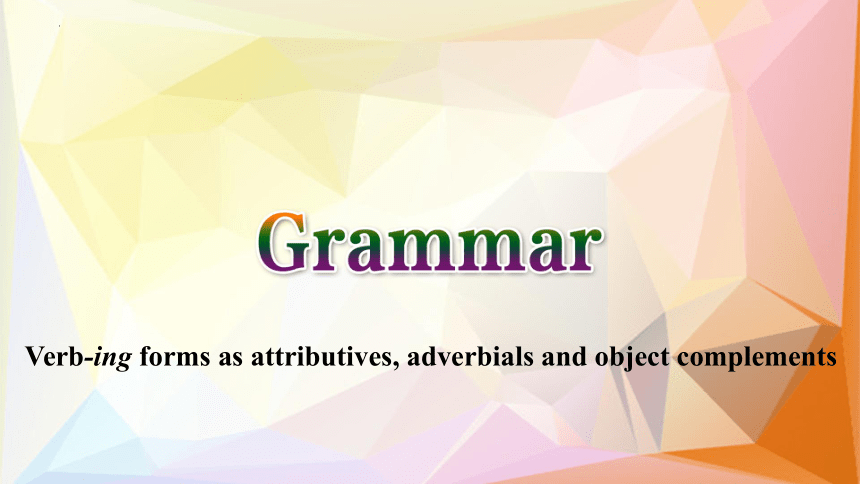
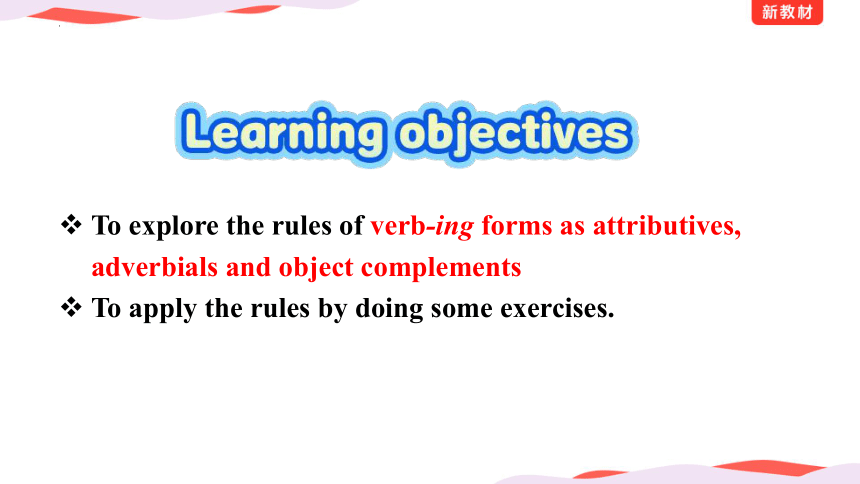
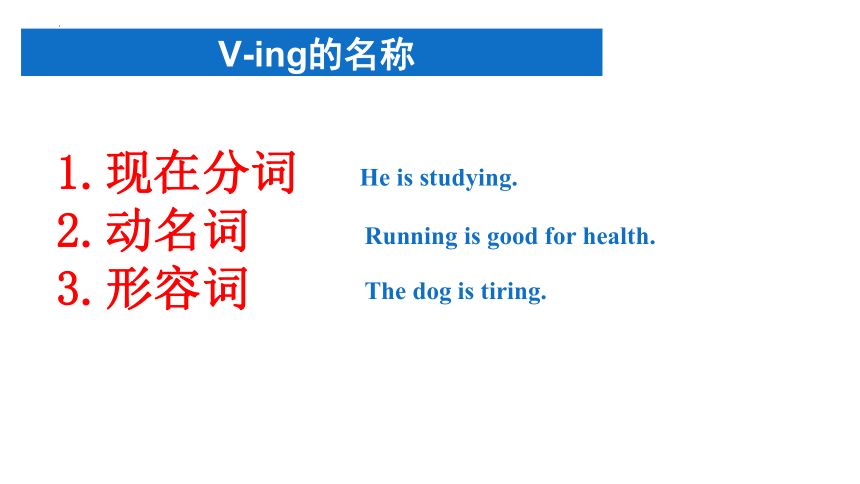
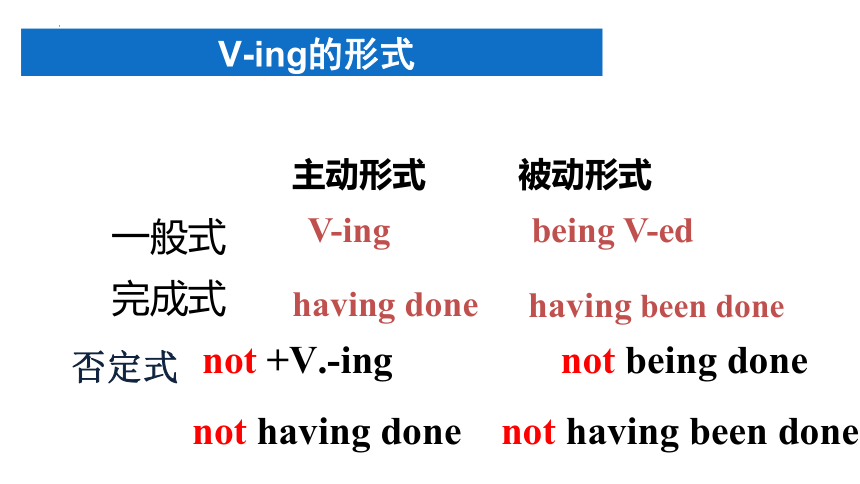
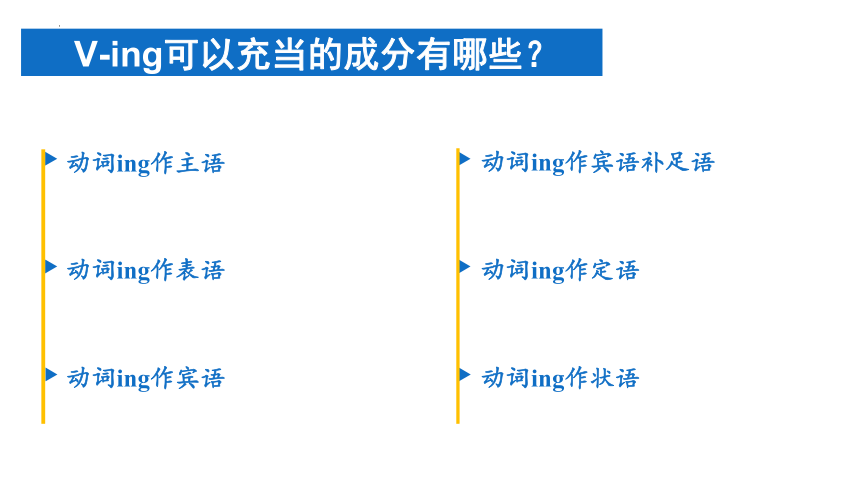
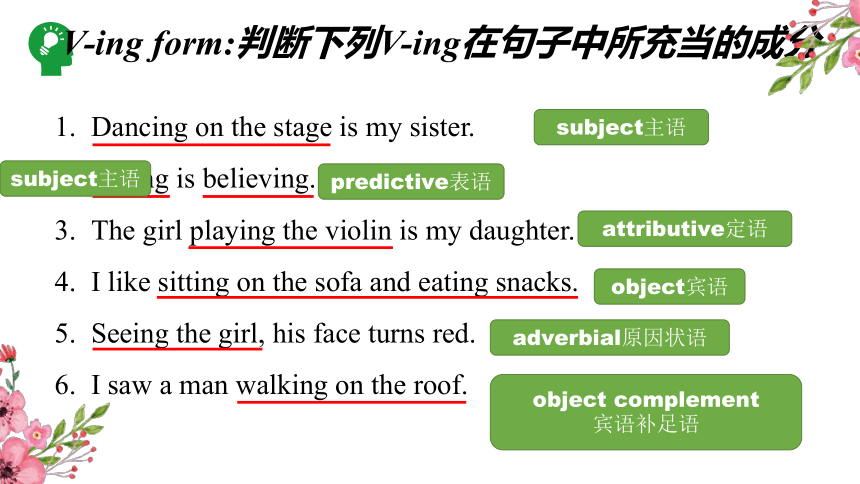

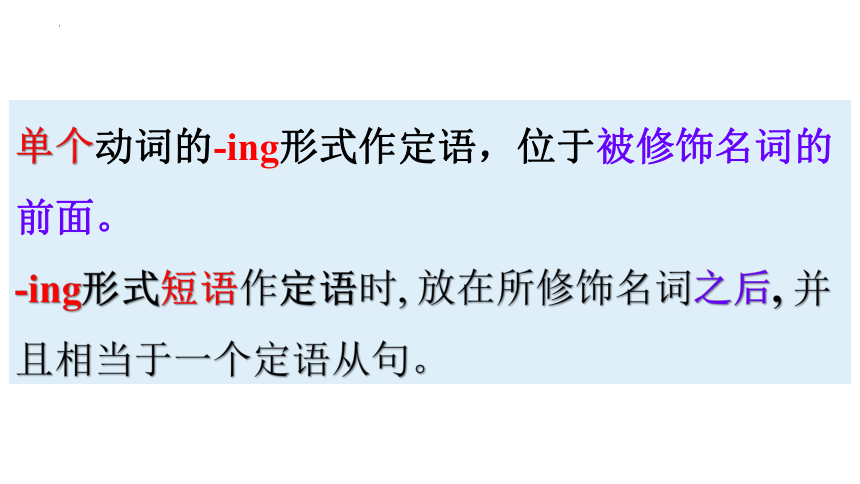
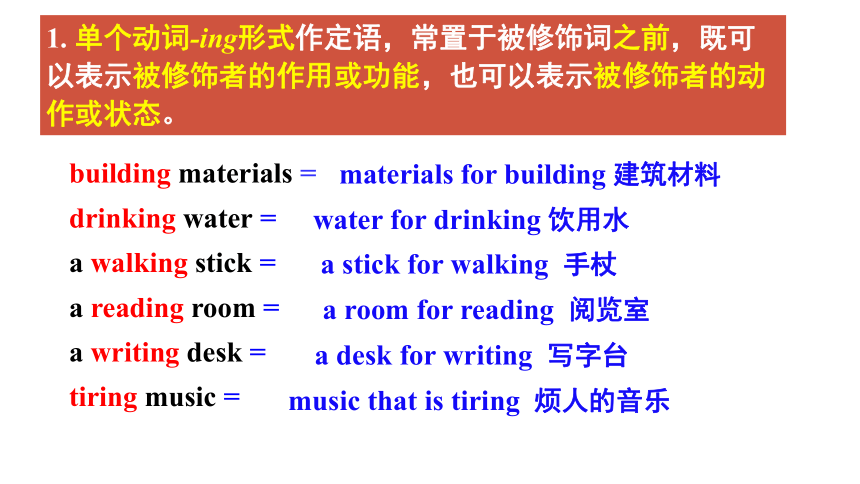
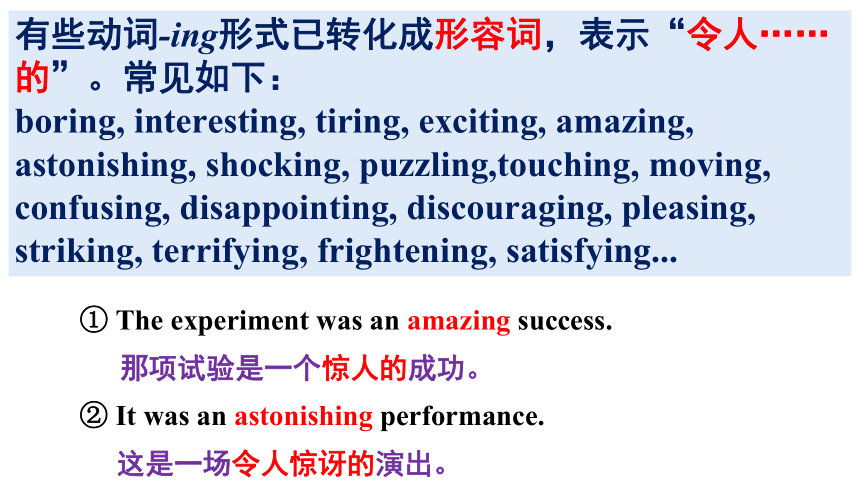
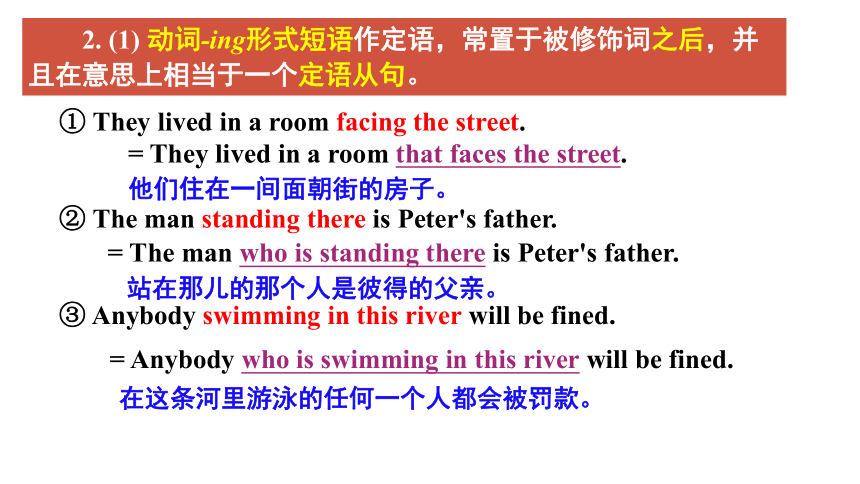
文档简介
(共60张PPT)
Unit 3
The world online
Verb-ing forms as attributives, adverbials and object complements
To explore the rules of verb-ing forms as attributives, adverbials and object complements
To apply the rules by doing some exercises.
V-ing的名称
1.现在分词
2.动名词
3.形容词
He is studying.
Running is good for health.
The dog is tiring.
V-ing的形式
主动形式 被动形式
一般式
完成式
V-ing
being V-ed
having done
having been done
否定式
not +V.-ing not being done
not having done not having been done
V-ing可以充当的成分有哪些?
动词ing作主语
动词ing作表语
动词ing作宾语
动词ing作宾语补足语
动词ing作定语
动词ing作状语
V-ing form:判断下列V-ing在句子中所充当的成分
Dancing on the stage is my sister.
Seeing is believing.
The girl playing the violin is my daughter.
I like sitting on the sofa and eating snacks.
Seeing the girl, his face turns red.
I saw a man walking on the roof.
subject主语
subject主语
predictive表语
attributive定语
object宾语
adverbial原因状语
object complement
宾语补足语
一、动词-ing形式作定语
单个动词的-ing形式作定语,位于被修饰名词的前面。
-ing形式短语作定语时, 放在所修饰名词之后, 并且相当于一个定语从句。
1. 单个动词-ing形式作定语,常置于被修饰词之前,既可以表示被修饰者的作用或功能,也可以表示被修饰者的动作或状态。
building materials =
drinking water =
a walking stick =
a reading room =
a writing desk =
tiring music =
materials for building 建筑材料
water for drinking 饮用水
a stick for walking 手杖
a room for reading 阅览室
a desk for writing 写字台
music that is tiring 烦人的音乐
有些动词-ing形式已转化成形容词,表示“令人……的”。常见如下:
boring, interesting, tiring, exciting, amazing, astonishing, shocking, puzzling,touching, moving, confusing, disappointing, discouraging, pleasing, striking, terrifying, frightening, satisfying...
① The experiment was an amazing success.
② It was an astonishing performance.
那项试验是一个惊人的成功。
这是一场令人惊讶的演出。
① They lived in a room facing the street.
② The man standing there is Peter's father.
③ Anybody swimming in this river will be fined.
= They lived in a room that faces the street.
他们住在一间面朝街的房子。
= The man who is standing there is Peter's father.
站在那儿的那个人是彼得的父亲。
= Anybody who is swimming in this river will be fined.
在这条河里游泳的任何一个人都会被罚款。
2. (1) 动词-ing形式短语作定语,常置于被修饰词之后,并且在意思上相当于一个定语从句。
① He is reading something interesting.
他正在读有趣的内容。
若单个的动词-ing形式修饰的词为those, something, everything, nothing等代词时,则动词-ing形式要放在其后。
2. (2)动词-ing形式短语也可以用作非限制定语,相当于一个非限制性定语从句,这时,它与句子其他部分用逗号分开。
① His brother, working as a teacher, lives in Beijing.
= His brother, who is working as a teacher, lives in Beijing.
他的哥哥住在北京,是个教师。
1. _________(bark) dogs seldom bite.
2. The wolf yelled in a ____________ voice and Lily felt____________. (frighten)
3. It’s pleasure to watch the face of a ________(sleep) baby.
4. The _________(shake) buildings showed us that an
earthquake was coming.
5. He was____________ by the ____________ performance.(astonish)
Barking
frightening
frightened
sleeping
shaking
astonishing
astonished
练习:将下列句子用适当形式补充完整
① They are living in a house facing the lake.
② The teachers working in this university can apply for an apartment for free.
③ The apple tree, swaying gently in the breeze, had a good crop of fruit.
练习:将下列句子改为含有定语从句的形式
= They are living in a house that faces the lake.
= The teachers who/that are working in this university can apply for an apartment for free.
= The apple tree, which was swaying gently in the breeze, had a good crop of fruit.
3. 动词-ing形式作定语,有被动形式。
动词-ing形式与被修饰词是被动关系,就用它的被动形式,即being done. Being done通常表示正在被做,常做后置定语。
① The tall building being built now is our new school.
② The question being discussed was presented by the
headmaster.
正在被建的高楼是我们的新学校。
正在被讨论的问题是被校长提出的。
1. 动词-ing形式作定语:
① 单个动词-ing形式作定语,常置于被修饰词_______。
② 动词-ing形式短语作定语,常置于被修饰词______,
相当于一个_________,也可以用作非限制定语,相当于一个__________________。
③ 动词-ing形式作定语,有______形式。
之前
之后
定语从句
非限制性定语从句
被动
4.现在分词作定语,表示_______和_______的意思。
表示正在发生的动作或存在的状态
主动
进行
二、动词-ing形式作状语
II. V-ing形式作状语
① 时间状语
② 原因状语
③ 条件状语
④ 结果状语
⑤ 让步、方式、伴随状语
可转化成相对应的状语从句 或 在V-ing前面加相应连词
主要用法
注意
时态
语态
否定式
独立主格
评注性状语
1. Standing by the window, I saw a beautiful flower.
2. Being poor, she couldn't afford it.
3. He sat in the sofa reading a book.
4. Using the new tool, you will finish the task quickly.
5. His father died, leaving the family even worse off
6. Studying hard, he didn't pass the exam.
7. He earns a living driving a taxi.
动词-ing形式可以表示时间、原因、结果、条件、让步、方式或伴随状况等,其作用相当于状语从句或并列句。
时间
原因
结果
伴随
条件
让步
方式
想一想,怎么变?
1. Standing by the window, I saw a beautiful flower.
2. Being poor, she couldn't afford it.
3. He sat in the sofa reading a book.
4. Using the new tool, you will finish the task quickly.
5. His father died, leaving the family even worse off.
6. Studying hard, he didn't pass the exam.
7. He earns a living driving a taxi.
动词-ing形式可以表示时间、原因、结果、条件、让步、方式或伴随状况等,其作用相当于状语从句或并列句。
时间
原因
结果
伴随
条件
让步
方式
想一想,怎么变?
When I stood
Because she was poor
and read
If you use
and left
Though he studied hard
by driving
1. Walking in the street, I came across an old friend of mine.
(=When I was walking in the street, I came across an old friend of mine.)
2. Being ill, he didn’t go to school.
(=As he was ill, he didn’t go to school.)
3. Using your head, you will find a way.
(=If you use your head, you will find a way.)
4. Walking ahead, you will see a white house.
(=If you walk ahead, you will see a white house.)
练习:将下列句子改为含有状语从句的形式
要注意各种形式变化:
主动形式 被动形式
动词-ing作状语
一般式
完成式
V-ing
being V-ed
having V-ed
having been V-ed
听到铃声,学生们开始走进教室。
Hearing the bell, the students began to enter the classroom.
听见和进入两个动作同时相继发生
正在建造的大楼是我们的新图书馆。
The building being built now is our new library.
being built为现在分词的被动形式,表示动作正在进行之中。
完成了工作,他就回家了。
Having done the work, he went home.
一般式
完成式
V.-ing
having V.-ed
否定式
not +V.-ing not having+ V.-ed
动词-ing形式的否定式
1. ____________ (know) the time of the meeting, he didn’t come.
________________ (make) full preparations, we put off the sports meeting.
3. ____________ (know) his new address, I couldn't go to see him yesterday.
Not knowing
Not having made
Not knowing
1. For a moment, I hesitated, not ________(want) to tell her the truth.
2. _________ (use) as a means of traffic in China, the bike is very useful and convenient.
3. The amusement park____________(build) over there now is a new theme park.
4. The song ________(sing) all over the country, _______(make) it the most popular song.
5. We are all nervous about the _______(come) exams.
6. ____________________ (not invite) to the party, Lucy was upset.
wanting
Used
being built
making
练习:将下列句子用适当形式补充完整
coming
is sung
Not having been invited
动词-ing形式用作状语时,其逻辑主语与句子主语一致。
Check the sentences.
Being tired, I asked John to have a rest.
Being tired, John had a rest.
独立主格结构
动词ing形式作状语,有时它也可以有自己的独立主语,这种结构称为独立主格结构,通常用来表示伴随的动作或情况,也可以表示时间,原因或条件。
那些树非常高,其中一些测量为90多米。
The trees are extremely tall, some over 90 meters.
由于天气好,我们去散步了。
The weather ,we went out for a walk.
being fine
measuring
一般来说
从……判断
从全盘考虑
e.g.从他的行为来判断,他一定是疯了。
动词 ing形式作评注性状语
有些动词 ing形式在句中没有逻辑主语,它们往往作为句子的评注性状语来修饰整个句子,表明说话者的态度,观点等。
generally speaking
judging by/from ...
taking everything into consideration
Judging from his behaviour, he must be mad.
2. 动词-ing形式作状语:
动词-ing形式可用作状语,可以表示_____、 _____、_____、_____、_____、_____或 _________等,其作用相当于状语从句或并列句。
时间
原因
结果
条件
让步
方式
伴随状况
三、动词-ing形式作宾语补足语
①表感觉和心理状态的感官动词
see/hear/feel/smell…+sb +doing sth.
②使役动词“使,让”
have/let/keep…+sb/sth + doing sth.
III. V-ing形式作宾补
(1)表示感觉和心理状态的感官动词,常见的有see, hear, feel,smell, find, notice, observe, look at, listen to等。
我感觉到有人拍了一下我的肩膀。
I felt somebody patting me on the shoulder.
你能闻到烧焦的味道吗?
Can you smell anything burning
我没有注意到他正在大门口等着。
I didn’t notice him waiting at the gate.
V-ing形式作宾补
(2)使役动词,“使,让”,have/let/keep…+sb/sth + doing sth.常见的还有set, get, catch, leave等。
我不愿意让你一直做那件事。
I won’t have you doing that.
对不起,让你一直等了那么久。
I’m sorry to have kept you waiting.
我不能让钟表再运行了。
I can’t get the clock going again.
V-ing形式作宾补
①He was last seen (read) in the library.
②When I entered the classroom, I saw him (try) to open the locker.
③They kept us waiting for three hours.(变被动语态)
→We for three hours.
④We saw him put on his coat and walk out.(变被动语态)
→He his coat and walk out.
reading
trying
were kept waiting
was seen to put on
练习:将下列句子用适当形式补充完整
3. 动词-ing形式作宾语补足语:
① 动词-ing形式作宾语补足语常放在______后面。
② 当主句转换为被动结构时,原来作宾语补足语的动词
-ing形式便转换为_____________。
③ 能用动词-ing形式作宾语补足语的动词:
表示_____、_________和指使意义的。
宾语
主语补足语
感观
心理状态
1. 动词-ing形式作定语:
① 单个动词-ing形式作定语,常置于被修饰词
_______。
② 动词-ing形式短语作定语,常置于被修饰词
______,相当于一个_________,也可以用作
非限制定语,相当于一个________________。
③ 动词-ing形式作定语,有______形式。
之前
之后
定语从句
非限制性定语从句
被动
2. 动词-ing形式作状语:
动词-ing形式可用作状语,可以表示_____、_____、_____、_____、_____、_____、 _______等,其作用相当于状语从句或并列句。
时间
原因
结果
条件
让步
方式
伴随状况
3. 动词-ing形式作宾语补足语:
① 动词-ing形式作宾语补足语常放在_____ 后面。
② 当主句转换为被动结构时,原来作宾语补
足语的动词-ing形式便转换为_________。
③ 能用动词-ing形式作宾语补足语的动词:
表示_____、_________和指使意义的。
宾语
主语补足语
感观
心理状态
四、动词-ing形式作主语
动词ing作主语
A
A. 一般形式
Coming to Hangzhou by train takes about 3 hours.
B. it 作形式主语
It no use arguing with him.
C. There be 句式
There is no harm in doing so.
五、动词-ing形式作表语
动词ing作表语
A
A. 动名词(相当于名词)
My favorite sport is swimming.
Their job is cleaning the window.
B. 现在分词(相当于形容词)
The food smells inviting.
The reason he gave was very convincing.
六、动词-ing形式作宾语
动词ing作宾语
A
A. 动词/动词短语后
I suggest doing it in a different way.
Glick had a bad accident two years ago and had to give up farming.
B. 介词后
I warned her against driving fast.
Do you feel like eating out tonight
有些动词可以用动名词作宾语。例如:
admit 承认 appreciate 感激 avoid 避免 complete完成 consider认为
delay 耽误 deny 否认 detest 讨厌 endure 忍受 enjoy 喜欢
escape 逃脱 fancy 想象 finish 完成 imagine 想象 mind 介意
miss 想念 postpone推迟 practice 训练 recall 回忆 resent 讨厌 resume 继续 resist 抵抗 risk 冒险 suggest 建议 face 面对
include 包括 stand 忍受 understand 理解 forgive 宽恕 keep 继续
Fill in the blanks.
1. He rushed into the ________ (burn) house.
2. The child _________ (stand) over there is my brother.
3. The room _________ (face) south is our classroom.
4. The man, ________ (talk) to the teacher, is our monitor's father.
5. Success makes sense to you only when you choose something ___________ (challenge).
burning
challenging
standing
facing
talking
1. And when he saw the mists rising from the river and the soft clouds _____________(surround) the mountain tops, he was reduced to tears. (2020 全国Ⅲ卷)
surrounding
Ⅰ.实战高考。
2. All the football players on the playground cheered loudly, ________ (say) that I had a talent for football.
(2019全国卷I)
3. Nervously ______ (face) challenges, I know I will whisper myself the two simple words “Be yourself”.
(2019北京卷)
saying
facing
4. If you are a teenager _______ (live) in certain parts of the province, you could be eligible(符合条件) for this program, which provides eight weeks of paid employment along with training.
(2019全国卷Ⅰ)
5. With ________ (shine) dark eyes, he seems like the kind of kid who would enjoy public speaking. (2019全国卷Ⅰ)
6. “After all, everyone has bad days and good days,” he said. “Some days you need a _______ (help) hand and some days you can be the one _______ (give) the _______ (help) hand.”
(2019浙江卷)
living
shining
helping
giving
helping
Anna is reading an article about a website. Find the verb-ing forms in the table below. The first ones have been done for you.
A Exploring the rules
Anna is reading an article about a website. Find the
verb-ing forms in the article and fill in the table below.
The first ones have been done for you.
A Exploring the rules
V-ing forms as attributives a website belonging to all dance lovers
V-ing forms as adverbials Taking advantage of the site's great start
V-ing forms as object complements she watched her daughter dancing
the lady running the website / inspiring stories
She always found dance relaxing
Having achieved such success
Working out the rules
The verb-ing form can be used like an adjective or an adverb, indicating a/an (1) ________(active/passive) meaning.
When the verb-ing form is used as an attributive, it often comes (2)_________(before/after) the noun, but the verb-ing phrases used as an attributive is usually put (3)________ (before/after) the noun.
When used as an adverbial, the verb-ing form can express time, reason, purpose, result or condition.
The verb-ing form can also be used as an object complement.
active
before
after
Applying the rules
B1
1. I saw that Jess was doing research online in the
computer room.
I saw _______________________ in the computer room.
2. Anybody who goes online should be careful about their
personal information.
____________________ should be careful about their
personal information.
3. When he heard the news, he jumped for joy.
_________________, he jumped for joy.
4. After I searched the Internet for information, I started
writing my article.
_______________________________________, I started
writing my article.
Jess doing research online
Anybody going online
Hearing the news
Having searched the Internet for information
B2
amaze cut have run use think
Anna: Jen, I love your new haircut. It looks great!
Jen: Thanks! I chose it online. I was always worried about picking a wrong style. That got me (1) __________- what if someone could choose it for me
Anna: What do you mean
Jen: I found this (2) ________ app. If you upload a photo of your face, it'll recommend a few haircuts to you.
Anna: Sounds super, but what if I don't like the recommended haircuts
Jen: In that case, you can choose different styles from hundreds of hairstyles and try them out. You can also share pictures of your chosen haircuts on social media and let your friends choose one for you!
Anna: Cool! What did the person (3) ________ your hair think about the app
Jen: She said it would make her job easier. (4) _________ apps like this, people are more likely to find satisfactory haircuts.
Anna: I agree. (5) ___________ a few bad haircuts myself, I'm always a little nervous about having a new haircut. I'll download it and get it (6) ___________.
thinking
amazing
cutting
Using
Having had
running
B3 In pairs, describe the picture below using verb-ing forms as attributives, adverbials or object complements. Use the example to help you.
S1: The family chatting online look so happy.
S2: Chatting online with the girl's mum, the family are having a good time.
S3: I can see the family chatting happily online.
将下面每组句子合并成一个含有verb-ing的句子,并使句意保持不变。
1. We climbed to the top of the tower. We saw fantastic scenery.
2. Larry went out. Larry shut the door behind him.
Climbing to the top of the tower, we saw fantastic scenery.
Larry went out shutting the door behind him.
3. The village is made up of 490 families. The 490 families belong to five nationalities.
4. Many Chinese brands have developed their reputations over centuries. They are facing new challenges from the modern market.
Having developed their reputations over centuries, many Chinese brands are facing new challenges from the modern market.
The village is made up of 490 families belonging to five nationalities.
Write five sentences using verb-ing forms as attributives, adverbials or object complements.
Unit 3
The world online
Verb-ing forms as attributives, adverbials and object complements
To explore the rules of verb-ing forms as attributives, adverbials and object complements
To apply the rules by doing some exercises.
V-ing的名称
1.现在分词
2.动名词
3.形容词
He is studying.
Running is good for health.
The dog is tiring.
V-ing的形式
主动形式 被动形式
一般式
完成式
V-ing
being V-ed
having done
having been done
否定式
not +V.-ing not being done
not having done not having been done
V-ing可以充当的成分有哪些?
动词ing作主语
动词ing作表语
动词ing作宾语
动词ing作宾语补足语
动词ing作定语
动词ing作状语
V-ing form:判断下列V-ing在句子中所充当的成分
Dancing on the stage is my sister.
Seeing is believing.
The girl playing the violin is my daughter.
I like sitting on the sofa and eating snacks.
Seeing the girl, his face turns red.
I saw a man walking on the roof.
subject主语
subject主语
predictive表语
attributive定语
object宾语
adverbial原因状语
object complement
宾语补足语
一、动词-ing形式作定语
单个动词的-ing形式作定语,位于被修饰名词的前面。
-ing形式短语作定语时, 放在所修饰名词之后, 并且相当于一个定语从句。
1. 单个动词-ing形式作定语,常置于被修饰词之前,既可以表示被修饰者的作用或功能,也可以表示被修饰者的动作或状态。
building materials =
drinking water =
a walking stick =
a reading room =
a writing desk =
tiring music =
materials for building 建筑材料
water for drinking 饮用水
a stick for walking 手杖
a room for reading 阅览室
a desk for writing 写字台
music that is tiring 烦人的音乐
有些动词-ing形式已转化成形容词,表示“令人……的”。常见如下:
boring, interesting, tiring, exciting, amazing, astonishing, shocking, puzzling,touching, moving, confusing, disappointing, discouraging, pleasing, striking, terrifying, frightening, satisfying...
① The experiment was an amazing success.
② It was an astonishing performance.
那项试验是一个惊人的成功。
这是一场令人惊讶的演出。
① They lived in a room facing the street.
② The man standing there is Peter's father.
③ Anybody swimming in this river will be fined.
= They lived in a room that faces the street.
他们住在一间面朝街的房子。
= The man who is standing there is Peter's father.
站在那儿的那个人是彼得的父亲。
= Anybody who is swimming in this river will be fined.
在这条河里游泳的任何一个人都会被罚款。
2. (1) 动词-ing形式短语作定语,常置于被修饰词之后,并且在意思上相当于一个定语从句。
① He is reading something interesting.
他正在读有趣的内容。
若单个的动词-ing形式修饰的词为those, something, everything, nothing等代词时,则动词-ing形式要放在其后。
2. (2)动词-ing形式短语也可以用作非限制定语,相当于一个非限制性定语从句,这时,它与句子其他部分用逗号分开。
① His brother, working as a teacher, lives in Beijing.
= His brother, who is working as a teacher, lives in Beijing.
他的哥哥住在北京,是个教师。
1. _________(bark) dogs seldom bite.
2. The wolf yelled in a ____________ voice and Lily felt____________. (frighten)
3. It’s pleasure to watch the face of a ________(sleep) baby.
4. The _________(shake) buildings showed us that an
earthquake was coming.
5. He was____________ by the ____________ performance.(astonish)
Barking
frightening
frightened
sleeping
shaking
astonishing
astonished
练习:将下列句子用适当形式补充完整
① They are living in a house facing the lake.
② The teachers working in this university can apply for an apartment for free.
③ The apple tree, swaying gently in the breeze, had a good crop of fruit.
练习:将下列句子改为含有定语从句的形式
= They are living in a house that faces the lake.
= The teachers who/that are working in this university can apply for an apartment for free.
= The apple tree, which was swaying gently in the breeze, had a good crop of fruit.
3. 动词-ing形式作定语,有被动形式。
动词-ing形式与被修饰词是被动关系,就用它的被动形式,即being done. Being done通常表示正在被做,常做后置定语。
① The tall building being built now is our new school.
② The question being discussed was presented by the
headmaster.
正在被建的高楼是我们的新学校。
正在被讨论的问题是被校长提出的。
1. 动词-ing形式作定语:
① 单个动词-ing形式作定语,常置于被修饰词_______。
② 动词-ing形式短语作定语,常置于被修饰词______,
相当于一个_________,也可以用作非限制定语,相当于一个__________________。
③ 动词-ing形式作定语,有______形式。
之前
之后
定语从句
非限制性定语从句
被动
4.现在分词作定语,表示_______和_______的意思。
表示正在发生的动作或存在的状态
主动
进行
二、动词-ing形式作状语
II. V-ing形式作状语
① 时间状语
② 原因状语
③ 条件状语
④ 结果状语
⑤ 让步、方式、伴随状语
可转化成相对应的状语从句 或 在V-ing前面加相应连词
主要用法
注意
时态
语态
否定式
独立主格
评注性状语
1. Standing by the window, I saw a beautiful flower.
2. Being poor, she couldn't afford it.
3. He sat in the sofa reading a book.
4. Using the new tool, you will finish the task quickly.
5. His father died, leaving the family even worse off
6. Studying hard, he didn't pass the exam.
7. He earns a living driving a taxi.
动词-ing形式可以表示时间、原因、结果、条件、让步、方式或伴随状况等,其作用相当于状语从句或并列句。
时间
原因
结果
伴随
条件
让步
方式
想一想,怎么变?
1. Standing by the window, I saw a beautiful flower.
2. Being poor, she couldn't afford it.
3. He sat in the sofa reading a book.
4. Using the new tool, you will finish the task quickly.
5. His father died, leaving the family even worse off.
6. Studying hard, he didn't pass the exam.
7. He earns a living driving a taxi.
动词-ing形式可以表示时间、原因、结果、条件、让步、方式或伴随状况等,其作用相当于状语从句或并列句。
时间
原因
结果
伴随
条件
让步
方式
想一想,怎么变?
When I stood
Because she was poor
and read
If you use
and left
Though he studied hard
by driving
1. Walking in the street, I came across an old friend of mine.
(=When I was walking in the street, I came across an old friend of mine.)
2. Being ill, he didn’t go to school.
(=As he was ill, he didn’t go to school.)
3. Using your head, you will find a way.
(=If you use your head, you will find a way.)
4. Walking ahead, you will see a white house.
(=If you walk ahead, you will see a white house.)
练习:将下列句子改为含有状语从句的形式
要注意各种形式变化:
主动形式 被动形式
动词-ing作状语
一般式
完成式
V-ing
being V-ed
having V-ed
having been V-ed
听到铃声,学生们开始走进教室。
Hearing the bell, the students began to enter the classroom.
听见和进入两个动作同时相继发生
正在建造的大楼是我们的新图书馆。
The building being built now is our new library.
being built为现在分词的被动形式,表示动作正在进行之中。
完成了工作,他就回家了。
Having done the work, he went home.
一般式
完成式
V.-ing
having V.-ed
否定式
not +V.-ing not having+ V.-ed
动词-ing形式的否定式
1. ____________ (know) the time of the meeting, he didn’t come.
________________ (make) full preparations, we put off the sports meeting.
3. ____________ (know) his new address, I couldn't go to see him yesterday.
Not knowing
Not having made
Not knowing
1. For a moment, I hesitated, not ________(want) to tell her the truth.
2. _________ (use) as a means of traffic in China, the bike is very useful and convenient.
3. The amusement park____________(build) over there now is a new theme park.
4. The song ________(sing) all over the country, _______(make) it the most popular song.
5. We are all nervous about the _______(come) exams.
6. ____________________ (not invite) to the party, Lucy was upset.
wanting
Used
being built
making
练习:将下列句子用适当形式补充完整
coming
is sung
Not having been invited
动词-ing形式用作状语时,其逻辑主语与句子主语一致。
Check the sentences.
Being tired, I asked John to have a rest.
Being tired, John had a rest.
独立主格结构
动词ing形式作状语,有时它也可以有自己的独立主语,这种结构称为独立主格结构,通常用来表示伴随的动作或情况,也可以表示时间,原因或条件。
那些树非常高,其中一些测量为90多米。
The trees are extremely tall, some over 90 meters.
由于天气好,我们去散步了。
The weather ,we went out for a walk.
being fine
measuring
一般来说
从……判断
从全盘考虑
e.g.从他的行为来判断,他一定是疯了。
动词 ing形式作评注性状语
有些动词 ing形式在句中没有逻辑主语,它们往往作为句子的评注性状语来修饰整个句子,表明说话者的态度,观点等。
generally speaking
judging by/from ...
taking everything into consideration
Judging from his behaviour, he must be mad.
2. 动词-ing形式作状语:
动词-ing形式可用作状语,可以表示_____、 _____、_____、_____、_____、_____或 _________等,其作用相当于状语从句或并列句。
时间
原因
结果
条件
让步
方式
伴随状况
三、动词-ing形式作宾语补足语
①表感觉和心理状态的感官动词
see/hear/feel/smell…+sb +doing sth.
②使役动词“使,让”
have/let/keep…+sb/sth + doing sth.
III. V-ing形式作宾补
(1)表示感觉和心理状态的感官动词,常见的有see, hear, feel,smell, find, notice, observe, look at, listen to等。
我感觉到有人拍了一下我的肩膀。
I felt somebody patting me on the shoulder.
你能闻到烧焦的味道吗?
Can you smell anything burning
我没有注意到他正在大门口等着。
I didn’t notice him waiting at the gate.
V-ing形式作宾补
(2)使役动词,“使,让”,have/let/keep…+sb/sth + doing sth.常见的还有set, get, catch, leave等。
我不愿意让你一直做那件事。
I won’t have you doing that.
对不起,让你一直等了那么久。
I’m sorry to have kept you waiting.
我不能让钟表再运行了。
I can’t get the clock going again.
V-ing形式作宾补
①He was last seen (read) in the library.
②When I entered the classroom, I saw him (try) to open the locker.
③They kept us waiting for three hours.(变被动语态)
→We for three hours.
④We saw him put on his coat and walk out.(变被动语态)
→He his coat and walk out.
reading
trying
were kept waiting
was seen to put on
练习:将下列句子用适当形式补充完整
3. 动词-ing形式作宾语补足语:
① 动词-ing形式作宾语补足语常放在______后面。
② 当主句转换为被动结构时,原来作宾语补足语的动词
-ing形式便转换为_____________。
③ 能用动词-ing形式作宾语补足语的动词:
表示_____、_________和指使意义的。
宾语
主语补足语
感观
心理状态
1. 动词-ing形式作定语:
① 单个动词-ing形式作定语,常置于被修饰词
_______。
② 动词-ing形式短语作定语,常置于被修饰词
______,相当于一个_________,也可以用作
非限制定语,相当于一个________________。
③ 动词-ing形式作定语,有______形式。
之前
之后
定语从句
非限制性定语从句
被动
2. 动词-ing形式作状语:
动词-ing形式可用作状语,可以表示_____、_____、_____、_____、_____、_____、 _______等,其作用相当于状语从句或并列句。
时间
原因
结果
条件
让步
方式
伴随状况
3. 动词-ing形式作宾语补足语:
① 动词-ing形式作宾语补足语常放在_____ 后面。
② 当主句转换为被动结构时,原来作宾语补
足语的动词-ing形式便转换为_________。
③ 能用动词-ing形式作宾语补足语的动词:
表示_____、_________和指使意义的。
宾语
主语补足语
感观
心理状态
四、动词-ing形式作主语
动词ing作主语
A
A. 一般形式
Coming to Hangzhou by train takes about 3 hours.
B. it 作形式主语
It no use arguing with him.
C. There be 句式
There is no harm in doing so.
五、动词-ing形式作表语
动词ing作表语
A
A. 动名词(相当于名词)
My favorite sport is swimming.
Their job is cleaning the window.
B. 现在分词(相当于形容词)
The food smells inviting.
The reason he gave was very convincing.
六、动词-ing形式作宾语
动词ing作宾语
A
A. 动词/动词短语后
I suggest doing it in a different way.
Glick had a bad accident two years ago and had to give up farming.
B. 介词后
I warned her against driving fast.
Do you feel like eating out tonight
有些动词可以用动名词作宾语。例如:
admit 承认 appreciate 感激 avoid 避免 complete完成 consider认为
delay 耽误 deny 否认 detest 讨厌 endure 忍受 enjoy 喜欢
escape 逃脱 fancy 想象 finish 完成 imagine 想象 mind 介意
miss 想念 postpone推迟 practice 训练 recall 回忆 resent 讨厌 resume 继续 resist 抵抗 risk 冒险 suggest 建议 face 面对
include 包括 stand 忍受 understand 理解 forgive 宽恕 keep 继续
Fill in the blanks.
1. He rushed into the ________ (burn) house.
2. The child _________ (stand) over there is my brother.
3. The room _________ (face) south is our classroom.
4. The man, ________ (talk) to the teacher, is our monitor's father.
5. Success makes sense to you only when you choose something ___________ (challenge).
burning
challenging
standing
facing
talking
1. And when he saw the mists rising from the river and the soft clouds _____________(surround) the mountain tops, he was reduced to tears. (2020 全国Ⅲ卷)
surrounding
Ⅰ.实战高考。
2. All the football players on the playground cheered loudly, ________ (say) that I had a talent for football.
(2019全国卷I)
3. Nervously ______ (face) challenges, I know I will whisper myself the two simple words “Be yourself”.
(2019北京卷)
saying
facing
4. If you are a teenager _______ (live) in certain parts of the province, you could be eligible(符合条件) for this program, which provides eight weeks of paid employment along with training.
(2019全国卷Ⅰ)
5. With ________ (shine) dark eyes, he seems like the kind of kid who would enjoy public speaking. (2019全国卷Ⅰ)
6. “After all, everyone has bad days and good days,” he said. “Some days you need a _______ (help) hand and some days you can be the one _______ (give) the _______ (help) hand.”
(2019浙江卷)
living
shining
helping
giving
helping
Anna is reading an article about a website. Find the verb-ing forms in the table below. The first ones have been done for you.
A Exploring the rules
Anna is reading an article about a website. Find the
verb-ing forms in the article and fill in the table below.
The first ones have been done for you.
A Exploring the rules
V-ing forms as attributives a website belonging to all dance lovers
V-ing forms as adverbials Taking advantage of the site's great start
V-ing forms as object complements she watched her daughter dancing
the lady running the website / inspiring stories
She always found dance relaxing
Having achieved such success
Working out the rules
The verb-ing form can be used like an adjective or an adverb, indicating a/an (1) ________(active/passive) meaning.
When the verb-ing form is used as an attributive, it often comes (2)_________(before/after) the noun, but the verb-ing phrases used as an attributive is usually put (3)________ (before/after) the noun.
When used as an adverbial, the verb-ing form can express time, reason, purpose, result or condition.
The verb-ing form can also be used as an object complement.
active
before
after
Applying the rules
B1
1. I saw that Jess was doing research online in the
computer room.
I saw _______________________ in the computer room.
2. Anybody who goes online should be careful about their
personal information.
____________________ should be careful about their
personal information.
3. When he heard the news, he jumped for joy.
_________________, he jumped for joy.
4. After I searched the Internet for information, I started
writing my article.
_______________________________________, I started
writing my article.
Jess doing research online
Anybody going online
Hearing the news
Having searched the Internet for information
B2
amaze cut have run use think
Anna: Jen, I love your new haircut. It looks great!
Jen: Thanks! I chose it online. I was always worried about picking a wrong style. That got me (1) __________- what if someone could choose it for me
Anna: What do you mean
Jen: I found this (2) ________ app. If you upload a photo of your face, it'll recommend a few haircuts to you.
Anna: Sounds super, but what if I don't like the recommended haircuts
Jen: In that case, you can choose different styles from hundreds of hairstyles and try them out. You can also share pictures of your chosen haircuts on social media and let your friends choose one for you!
Anna: Cool! What did the person (3) ________ your hair think about the app
Jen: She said it would make her job easier. (4) _________ apps like this, people are more likely to find satisfactory haircuts.
Anna: I agree. (5) ___________ a few bad haircuts myself, I'm always a little nervous about having a new haircut. I'll download it and get it (6) ___________.
thinking
amazing
cutting
Using
Having had
running
B3 In pairs, describe the picture below using verb-ing forms as attributives, adverbials or object complements. Use the example to help you.
S1: The family chatting online look so happy.
S2: Chatting online with the girl's mum, the family are having a good time.
S3: I can see the family chatting happily online.
将下面每组句子合并成一个含有verb-ing的句子,并使句意保持不变。
1. We climbed to the top of the tower. We saw fantastic scenery.
2. Larry went out. Larry shut the door behind him.
Climbing to the top of the tower, we saw fantastic scenery.
Larry went out shutting the door behind him.
3. The village is made up of 490 families. The 490 families belong to five nationalities.
4. Many Chinese brands have developed their reputations over centuries. They are facing new challenges from the modern market.
Having developed their reputations over centuries, many Chinese brands are facing new challenges from the modern market.
The village is made up of 490 families belonging to five nationalities.
Write five sentences using verb-ing forms as attributives, adverbials or object complements.
同课章节目录
- Unit 1 Nature in the balance
- Welcome to the unit
- Reading
- Grammar and usage
- Integrated skills
- Extended reading
- Project
- Unit 2 Natural disasters
- Welcome to the unit
- Reading
- Grammar and usage
- Integrated skills
- Extended reading
- Project
- Unit 3 The world online
- Welcome to the unit
- Reading
- Grammar and usage
- Integrated skills
- Extended reading
- Project
- Unit 4 Scientists who changed the world
- Welcome to the unit
- Reading
- Grammar and usage
- Integrated skills
- Extended reading
- Project
